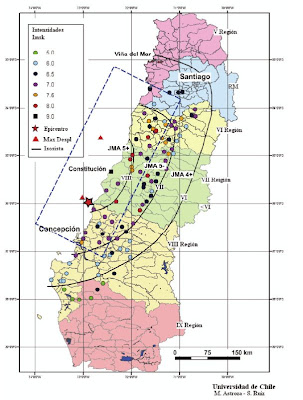My Famous Earthquakes list consists of those events where I learned something. From most of these earthquakes I have learned that PGV (peak ground velocity) is the best measure for damage potential, that some super-shear earthquakes put out a PGV of over 100 cm/s that destroys almost anything. In general, for good building stock, we shall start to see facade and plaster damage at 20 cm/s, some light structural damage to housing stock at 50 cm/s, and major structural damage at 100 cm/s.
A glimpse of where I'm heading with this:
Building codes have used the wrong physics for years. I've told them and they've come back with: Being Wrong is Conservative. Well, Chile has showed them that wrong is wrong. This is not good news for those waiting for a subduction earthquake (BC and Alaska).
Building codes have always evolved with disaster. Many earthquakes have had a profound effect on the codes, namely by showing them to be inadequate. This is expected because there are always new materials and building techniques, and no real handle on ground motion physics. Many assumptions had to be made. In the past decades there have been extensive changes with modern methods, and no real check since Northridge or 1971.
For a real check you need good accelerometer records, and modern buildings, built to the current code. Lucky for us, Chile has all of this.
The Chile earthquake of 2010 was a wonderful, classic, clean subduction earthquake, well recorded.
You can see the intensities. Santiago, with all the useful information is off to the side, with a moderate intensity of about V, where you shouldn't expect much damage in a modern city.
A more useful map is this huge thing, which shows the clean rupture and accelerations (in the unfortunate Japanese units).
I only found this in Japanese papers, the North American engineers have been scared into paralysis. Note that Santiago is a fraction of the hot zone. A PGV of 40 as opposed to 70 cm/s at ground zero.
To be continued.


No comments:
Post a Comment